Ahmad Shah Massoud
![]()
The neutrality of this article or section is disputed. A justification is on the discussion page. For more information, click here.
Ahmad Shah Massoud (Persian احمد شاه مسعود, also Ahmed Shah Masud, English transliteration Ahmad Shah Massoud; born 1 September 1953 in Punjir; † 9 September 2001 in Tachar) was an Afghan Mujahideen fighter and national hero. He was the leader of the Afghan resistance against the Taliban. He was named a "National Hero of the Afghan Nation" in late 2001.
Massoud, who belonged to the Tajik ethnic group, was a deeply devout Muslim and a convinced opponent of extremist (including Wahabi) interpretations of Islam, such as those pursued by the Taliban, al-Qaeda, or the Saudi royal family. Massoud, a Sunni, always carried a book of al-Ghazālī with him. For his followers, he was not only a military leader, but also a teacher and religious role model. They also call him Āmer Sāheb-e Shahīd (free translation: "[Our] beloved commander [and] martyr").
Massoud played a major role in the Soviet Union's military withdrawal from Afghanistan, which earned him the legendary name "Lion of Punjir. The Wall Street Journal called him "The Afghan Who Won the Cold War" on its cover. After the withdrawal of the Soviet Army and the fall of the communist regime in 1992, the Peshawar Accords, a peace treaty signed by various Afghan political parties, appointed Massoud as defense minister in the government of President Burhānuddin Rabbāni. However, militia leader Gulbuddin Hekmatyār, who was under the control of Pakistan's intelligence agency ISI and aspired to dictatorial power, launched a year-long war in the capital Kabul with the help of Pakistan. With Hekmatyār unsuccessful, Pakistan turned to the Taliban in 1994, who launched a military offensive in early 1995 and captured Kabul in September 1996 after several months of siege. Massoud retreated to northern Afghanistan. Under his leadership, the United Front became a national military-political resistance movement against the Taliban that included representatives of all ethnic groups in Afghanistan (Tajiks, Pashtuns, Uzbeks, Hazara, Turkmen, and others). Between 400,000 and 1,000,000 Afghan civilians fled the Taliban to areas under its control. Shortly after the deadly assassination of Massoud, who saw democracy as the only form of government capable of bringing lasting peace to Afghanistan, the United Front, with American air support, finally overthrew the Taliban regime in Kabul in late 2001 and established an interim government that ruled until democratic elections in 2004.
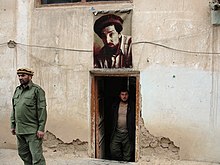
Portrait of Massoud at a checkpoint in the Punjir Valley .
Biography
Childhood and youth
In the early 1970s, there was a mood of change in Kabul, as people were dissatisfied with the king, who was considered corrupt. Massoud, then still a student at the "Kabul Polytechnic Institute of Engineering and Architecture", joined the Islamist and anti-communist movement - albeit not entirely out of conviction, but for lack of alternatives. Initially involved in a youth organization, he finally joined Burhānuddin Rabbāni's political party Jamiat-i Islāmi officially in 1976.
After a failed coup attempt by the Islamists against the government, Massoud was forced to leave Afghanistan and go into hiding for a short time in Pakistan, where he received military training. Back in Afghanistan, however, he henceforth advocated alongside Rabbāni for a more peaceful upheaval in Afghanistan. This led two Pakistani agents and the leader of the radical forces of the Islamist movement, Gulbuddin Hekmatyār, to make a first assassination attempt on Massoud in 1975, which he fended off.
Resistance to the Soviet Army
In 1978, it was finally the Afghan communists of the People's Democratic Party of Afghanistan who seized power in a violent coup. They pursued strict reform plans, but equally a reign of violence. Human Rights Watch estimates that between April 1978 and the invasion of the Soviet Union in December 1979, up to 100,000 people were murdered in the countryside alone.
In 1979, Soviet Union troops invaded Afghanistan after Prime Minister Hafizullah Amin had President Nur Muhammad Taraki assassinated and the civil war had escalated. The goal of the invasion was to remove Amin, who was feared to be switching sides to the United States. The insurgency had by this time reached 24 of the country's 28 provinces. Part of the Afghan army deserted. Even before the invasion of Soviet troops, Massoud had returned to his birthplace, the Panjshir valley on the Hindu Kush. From Panjshir onwards he played a central role in the Afghan resistance struggle. His guerrilla fighting and military prowess led to key defeats of Soviet forces. Nine major offensives of the Soviet army with tens of thousands of soldiers failed in Panjshir.
Robert D. Kaplan wrote in response:
"One must count Ahmad Shah Massoud among the greatest leaders of the resistance movements in the 20th century. Massoud defeated his enemy just as Marshal Tito, Ho Chi Minh and Che Guevara did. Massoud controlled a larger area that was much more difficult to hold from a military standpoint and under constant fire from the enemy. The area under his control was under greater attack by the enemy compared to the areas under the control of the resistance movement of Marshal Tito, Mao Tse Tung, Ho Chi Minh and Che Guevara."
- Robert D. Kaplan: The Soldiers of God. 1991
The militarily brilliant resistance attributed to him soon earned Massoud the name "Lion of Punjir". Massoud successfully defended Punjir until the retreat of the Soviet army. Ahmad Shah Massoud is credited with playing a very central role in the defeat of the Soviet Union in Afghanistan.
War in Kabul
After the final fall of the communist government in 1992, the Peshawar Accords established the Islamic State of Afghanistan. With the exception of Gulbuddin Hekmatyār, all political parties had agreed to this peace treaty in April 1992. Massoud was appointed Minister of Defense by the Peshawar Peace Accords (Peshawar Accords).
However, Afghanistan's neighboring countries, particularly Pakistan, Iran, and Uzbekistan, sought to establish strategic dominance over Afghanistan and financed, armed, and directed various criminal elements and militias within Afghanistan to this end. Although he was repeatedly offered the position of prime minister, Gulbuddin Hekmatyār, with Pakistan's support, laid claim to autocracy and reduced Kabul to rubble through a large-scale, long-term massive bombing campaign. Afghanistan expert and director of the Australian National University's Centre for Arab and Islamic Studies, Amin Saikal, concluded in Modern Afghanistan: A History of Struggle and Survival:
"Pakistan was intent on a breakthrough in Central Asia. ... Islamabad knew that the newly appointed Islamic government members [in Afghanistan] ... would not subordinate their own national interests to those of Pakistan so that Pakistan could fulfil its regional ambitions. ... Without logistical support and the supply of a large quantity of missiles by the ISI [Pakistani intelligence], Hekmatyar's forces could not have shelled and destroyed half of Kabul."
Various attempts to integrate Hekmatyār into the interim government as prime minister failed due to his unwillingness to compromise. In 1993, Hekmatyār explicitly demanded Massoud's resignation in return for his declaration that he would stop bombing Kabul. Massoud accepted the offer, officially resigned as defense minister, and retreated to a location north of the capital. Massoud's conditions were an end to the bombing of Kabul and democratic elections to be held at a later date. However, Hekmatyār, described as a "psychopath" by observers such as Pulitzer Prize winner Roy Gutman of the United States Institute of Peace, resumed the bombing of Kabul after an initial cabinet meeting, unwilling to work toward democratic elections or compromise with other parties. After a period in which a defense council had taken over but remained ineffective, Massoud, who led the strongest military alliance of the time, was reinstated as defense minister. His goal was the defense of the capital, the enforcement of the Peshawar Accords, which provided for democratic elections, and the reinstatement of the liberal constitution of 1964.
In addition to the Hekmatyār bombings, tensions had escalated in mid-1992 between the Saudi-backed Wahhabi Ittihad-i Islami of Abdul Rasul Sayyaf and the Iranian-backed Shiite Hezb-i Wahdat of Abdul Ali Mazari. The militias launched a bloody war against each other. The Hezb-i Wahdat militia formed an alliance with Hekmatyār in late 1992. Abdul Rashid Dostum and his Junbish-i Milli militia joined this alliance in early 1994. During the most intense phase of bombardment by Hekmatyar's alliance, over 25,000 people died in Kabul. Due to the rapid start of the war shortly after the establishment of the Islamic State, there was no functioning police force or legal system, leaving large parts of Kabul in chaos. A major contribution to the prevailing chaos was the fact that Gulbuddin Hekmatyār released 10,000 dangerous criminals from the prisons into the city.
In the wars started by Hekmatyār, the Ittihad and Wahdat, large parts of Kabul were destroyed and thousands of civilians were killed. Individuals from all militias-including individuals in Massoud's government forces and criminals released from prisons by Hekmatyār posing as members of them-exploited the chaos and lawlessness to commit crimes against civilians. Massoud condemned crimes taking place. The Afghanistan Justice Project, which also serves as a source for Human Rights Watch, concluded in its research in the context of attacks by armed individuals on civilians:
"As in some of the other instances of violence against civilians documented in this report, there is no indication that senior Shura-e Nazar leaders [which included Massoud] ordered the abuses. (As in
some of the other instances of violence against civilians documented in this report, there is no indication that senior Shura-e Nazar leaders [which included Massoud] ordered
abuses."
- Afghanistan Justice Project (2005)
Massoud was the leader of the Shura-e Nazar military and political alliance, which united over 130 commanders from seven provinces and their troops. Due to the heavy bombing against Kabul, starting from several fronts (on some days Hekmatyār bombed Kabul with up to 3,000 missiles), 10,000 additional fighters were sent to Kabul by Shura-e Nazar commanders who were under Massoud's overall command but not under his immediate and daily control. Individuals from the Shuar-e Nazar forces who committed crimes were, in the situation in Kabul at the time, sub-commanders acting individually or individuals who turned against the civilian population and/or became corrupt because the chaos gave them the opportunity to do so. One example that comes up frequently in this context is the military operation in Afshar, in western Kabul. This offensive, as analyzed by the Afghanistan Justice Project, had a "clear and comprehensible military objective." Starting in Afshar, Hekmatyārs and Mazaris forces, supported by Pakistan and Iran, bombed civilian residential neighborhoods in Kabul, killing thousands of people, in order to prevent the Islamic State from stabilizing. To stop these bombings, troops of Defense Minister Massoud and allied troops attacked the positions of Hekmatyār-allied Hezb-i Wahdat in Afshar. Towards the end of the military operation, however, after the military objectives had been achieved, while posts were being set up and houses searched for Wahdat fighters, Abdul Rasul Sayyaf's Wahhabi Ittihad troops in particular, who were also involved in the offensive and had their headquarters near Afshar and were officially fighting on the side of the state of Afghanistan, began to target Shiite civilians. Sayyaf's Ittihad forces were not under the control of the Afghan Ministry of Defense, but under direct control of Sayyaf and Wahhabi elements in Saudi Arabia. Ahmad Shah Massoud responded to the atrocities taking place, summoned Abdul Rasul Sayyaf, who would play a role in Massoud's assassination eight years later, and other senior commanders to a meeting and ordered an immediate end to the crimes on the second day of the offensive. He appointed a Shiite commander, Hussain Anwari, to restore security for Shiite civilians.
Edward Girardet, director of the Global Journalism Network in Geneva, who was directly on the ground as an observer at the time, explains:
"When Massoud operated in the north during the fight against the Soviet troops and towards the end of the Taliban period, he watched his commanders closely and controlled them well, but this was not the case in Kabul. ... He could not control them all."
- Edward Girardet: Global Journalism Network Geneva
Thus, Human Rights Watch also reports no human rights crimes committed by troops under the direct control of Ahmad Shah Massoud during the resistance against the Taliban for the period from October 1996 until Massoud's assassination in September 2001. Farid Amin reports an exemplary incident for the period in Kabul:
"One day Massoud was on his way from Kabul to Shamali and he saw a truck that seemed suspicious. He stopped it and when he had it opened there were valuables inside, things that belonged to other people and had probably been stolen from houses or government buildings. He accused them, 'You are thieves trying to steal.' Then he saw his own image in their truck - people trying to use Massoud's name and image to gain power or advantage - and he said, 'First remove the image of your leader, the leader of thieves.' In his own way, he informed them that if you say I am your leader and you do such things, then that is what you make of me - a leader of thieves."
- Farid Amin: in Massoud (Webster University Press 2009)
John Jennings, a journalist for the Associated Press and The Economist, was directly on the ground in Kabul from 1992 to 1994 as an observer for Human Rights Watch, among others, and was also present during the Afshar operation. He reports the following:
"He [Massoud] can hardly be blamed for the presence of irresponsible armed groups in the capital, having done everything in his power to prevent that presence. By November 1994, I witnessed firsthand the dilemmas he faced and the astonishing restraint with which he met them ... Every popular movement, if it truly emanates from the people, harbors a criminal element, if only because every major population harbors a criminal element. ... Crimes by his troops were rare and punished whenever they could be convicted. ... His enemies on the other side committed mass murder, theft and ethnic cleansing as a systematic policy. ... Had Massoud not fought to hold Kabul against the onslaught of these militias, the human rights situation in Afghanistan and throughout the region would have been considerably worse than it was."
- John Jennings: Associated Press
The militias fighting for the Islamic State and thus against the defense minister Massoud were notorious for their targeting of the civilian population. Gulbuddin Hekmatyār cut off Kabul's food, water, and energy supplies. Iranian-controlled Shia Wahdat forces (as well as the Saudi-backed Sunni Wahhabi Ittehad) kidnapped and killed thousands of people from the (respective) "opposite side" in targeted campaigns. Some of Rashid Dostum's troops were particularly feared by the civilian population at the time due to their attacks against families. The Taliban would later commit massacres that United Nations observers compared to those during the Bosnian war.
In 1993, he founded the "Mohammad Ghazali Cultural Foundation" (Bonyad-e Farhangi wa Ta'wani Mohammad-e Ghazali) which became the largest Afghan humanitarian partner for the International Red Cross and promoted Afghan culture in a non-partisan and politically independent manner. Part of the Ghazali Foundation employed doctors to provide free medical treatment and care a few days a week to Kabul residents who could not have financed such care otherwise. The Ghazali Foundation also employed social workers who counseled families.
In late 1994-early 1995, Massoud defeated the militias fighting for control of the capital, Kabul. The bombing of the capital came to a halt. The Islamic State government took steps to restore law and order, and courts resumed their work. Some individuals within the government forces who had committed crimes and been convicted were held accountable and sentenced. Massoud initiated a nationwide political process aimed at national consolidation, stabilization, and democratic elections. Three conferences were held with representatives from most of Afghanistan's provinces. Massoud also invited the Taliban to join this process and participate in creating stability.
Kandahar in the south of the country had also experienced bloody fighting in 1994. Southern Afghanistan was neither under the control of the central government nor under the control of externally controlled militias like the Hekmatyars. Local militia or tribal leaders had dominated this part of Afghanistan. In 1994, the Taliban had first appeared in the southern city of Kandahar. They had taken control of the city of Kandahar on November 5, 1994. By 25 November 1994, they controlled the city of Lashkar Gah and Helmand province. During 1994, they had captured other provinces in the south and west of the country that were not under the control of the central government. The Taliban rejected a democratic form of government.
In early 1995, the Taliban launched a large-scale bombing and siege campaign against Kabul that lasted two years. Amnesty International wrote:
"This is the first time in several months that Kabul's civilians have been the target of bombings that targeted residential neighborhoods in the city."
- Amnesty International (1995)
The Taliban initially suffered heavy defeats against Massoud's troops. International observers already suspected the end of the Taliban movement. For two years the Taliban besieged and bombed Kabul. In September 1996, the Taliban had regrouped with military support from Pakistan and financial aid from Saudi Arabia and planned a major offensive against Kabul. The then General and later President Pervez Musharraf and Interior Minister Nasirullah Babar, who referred to the Taliban as "our boys", were instrumental in Pakistan's financial and material support for the Taliban.
On September 26, 1996, Massoud ordered a strategic withdrawal of his forces into northern Afghanistan. On September 27, 1996, the Taliban invaded Kabul and established the Islamic Emirate of Afghanistan, which was recognized only by Pakistan, Saudi Arabia, and the United Arab Emirates. The government of the Islamic State of Afghanistan remained the internationally recognized government of Afghanistan (with a seat at the United Nations).
The rural regions devastated in the Soviet-Afghan war were hardly affected by fighting during the war in Kabul and reconstruction had begun. This changed when the Taliban attempted to extend their control over Afghanistan, pursuing a scorched earth policy.
Resistance to the Taliban
According to a United Nations report, the Taliban committed systematic massacres of civilians while trying to consolidate their position in western and northern Afghanistan. The United Nations named 15 massacres between 1996 and 2001, saying they were comparable to ethnic cleansing during the Bosnian War, "highly systematic, and all traceable to the [Taliban] Ministry of Defense or Mullah Omar personally." The so-called 055 Brigade of al-Qaida was also involved in atrocities against Afghan civilians. The United Nations report cites testimony describing Arab militiamen carrying long knives with which they slit throats and skinned people.
Massoud and Abdul Rashid Dostum, former opponents, originally founded the United Front in response to massive Taliban offensives against the areas under Massoud's control on one side and the areas under Dostum's control on the other. However, the United Front soon developed into a national political resistance movement against the Taliban. This was joined by the Hazara ethnic group, persecuted by the Taliban through ethnic cleansing, as well as anti-Taliban Pashtun leaders such as the future president Hamid Karzai, who hails from southern Afghanistan, and Abdul Qadir. Qadir came from an influential family which enjoyed great influence in the Pashtun east of Afghanistan around Jalalabad. Altogether, representatives from all parts and all ethnic groups of Afghanistan joined the United Front.
The human rights situation depended on the particular commanders who controlled certain areas. Human Rights Watch records no human rights crimes for troops under Massoud's direct control for the period from October 1996 until his assassination in September 2001. Massoud had control over Punjir, Tachar, some parts of Parwan and Badakshan. In the meantime, Nuristan, Kunduz and the areas north of Kabul were also under his control.
After the defeat of Dostum and other regional leaders, Massoud remained the only commander who could successfully defend his territories against the Taliban. Pakistan intervened militarily on the side of the Taliban, but could not bring about Massoud's defeat.
Pakistani President Pervez Musharraf - then Chief of Staff of the military, among others - sent tens of thousands of Pakistanis to fight alongside the Taliban and al-Qaeda against the United Front. In total, estimates put the number of Pakistani nationals who fought inside Afghanistan at 28,000. 20,000 of these were regular Pakistani soldiers in the so-called Frontier Corps or Army. Another estimated 8,000 were militiamen recruited in so-called madrassas to fight within the Taliban's army. A 1998 U.S. State Department document confirms, "20-40 percent of [regular] Taliban soldiers are Pakistani." The State Department report also describes that parents of Pakistani citizens "do not know of their children's military involvement with the Taliban until their [dead] bodies are brought back to Pakistan."
Another 3000 soldiers of the regular Taliban army were militiamen from Arab countries or Central Asia. From 1996 to 2001, Osama bin Laden and Aiman az-Zawahiri's al-Qaeda became a state within the Taliban state. Bin Laden sent his recruits against the United Front.
Of an estimated 45,000 soldiers who fought against the United Front inside Afghanistan, only about 14,000 were Afghans.
Massoud rejected repeated offers by the Taliban to give him a position of power. He stated in an interview:
"The Taliban say, 'Come and accept the post of prime minister and join us,' and they would keep the highest office in the land, the presidency. But for what a price! The difference between us lies in how we think about the most fundamental principles of society and government. We cannot accept their conditions for compromise, otherwise we would have to abandon the principles of a modern democracy. We are fundamentally against the system which calls itself 'the Emirate of Afghanistan'. [...] There should be an Afghanistan where every Afghan can feel happy. And I think this can only be secured through a democracy based on consensus."
Massoud's peace proposal had the goal of democratic elections in which the Afghan people themselves would decide on their leadership. In early 2001, the United Front employed a new strategy of local military pressure and a global political agenda. Resentment and opposition to the Taliban, starting from the roots of Afghan society, became increasingly strong. This also affected the Pashtun areas. In total, an estimated one million people fled the Taliban, much of it to Massoud's areas. The National Geographic concluded in its documentary Inside the Taliban:
"The only thing standing in the way of future Taliban massacres is Ahmad Shah Massoud."
- National Geographic: Inside the Taliban
In the areas under his control, Massoud established democratic institutions and signed the Declaration for Women's Rights. He trained more police forces to prevent a repeat of the chaos in Kabul (1992-1994) if the United Front were to succeed.
In the spring of 2001, Massoud addressed the European Parliament in Brussels and asked the international community for humanitarian aid for the people of Afghanistan. He stated that the Taliban and al-Qaeda had introduced a "very wrong interpretation of Islam" and that if the Taliban did not have the support of Pakistan, they would not be able to sustain their military campaigns in the space of a year. On his visit to Europe, during which European Parliament Speaker Nicole Fontaine called him the "pole of freedom in Afghanistan," Massoud warned that his intelligence agency had information that a large-scale attack on American soil was imminent.
September 9, 2001
On 9 September 2001, Abd al-Sattar and Bouraoui el Ouaer, two al-Qaeda suicide bombers who had posed as Belgian journalists, detonated a bomb they had hidden in their video camera during an interview with Massoud in Tachar. Massoud died of his injuries a short time later. Immediately afterwards, the Taliban began an offensive against Massoud's troops, whose death had initially been denied by official sources. According to the latest findings, groups in 21 nations were working to assassinate Massoud. Previously, several assassination attempts by the Soviet, Afghan Communist and Pakistani intelligence services, as well as Hekmatyar, the Taliban and al-Qaida, had failed over a period of 26 years. Close associates of Massoud report that Massoud had a premonition of his death in the weeks before his death and increasingly tried to prepare family members for the possibility. The funeral, contrary to Islamic tradition, did not take place until September 16, a week after Massoud's death. Although the funeral took place in the very rural Punjir Valley, tens of thousands of grieving Afghans attended. The modus operandi of the assassination was similar to that of the 1984 La Penca assassination of Edén Pastora Gómez in the Costa Rica/Nicaragua border area during the Contra war.
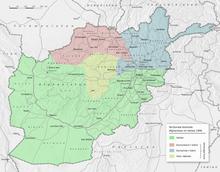
Territorial control in Afghanistan at the end of 1996: Massoud (blue), Taliban (green), Dostum (pink), Hezb-i Wahdat (yellow)
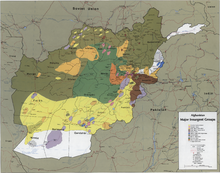
Resistance groups against Soviet troops in 1985; army green shows positions of Jamiat-i Islami, to which Massoud belonged. The Shura-e Nazar, led by Massoud from 1984, included many Jamiat positions, as well as those of other groups, and controlled the supply routes needed by Soviet troops through the Hindu Kush and on the border with the Soviet Union.
National hero and "Lion of Pandjir"
Massoud has taken a central and very significant role in Afghanistan's recent history. In 2001, he was officially declared a "national hero of the Afghan nation" by Afghan President Hamid Karzai. Massoud's death anniversary, September 9, is a national day of remembrance.
In 1989, when the Soviet Union was forced to withdraw from Afghanistan after ten years of defeat and humiliation, the Wall Street Journal devoted a cover to Ahmad Shah Massoud: The Afghan Who Won The Cold War. During the Taliban's rule, Massoud provided the only protection for persecuted people and the only resistance to the Taliban. While other leaders went into exile, he was the only one of Afghanistan's known military and political leaders who never left Afghanistan at any point during the invasion by Soviet troops and later by the Pakistan-backed Taliban.
He is regarded as a folk hero by many Afghans - even outside Afghanistan, such as in Tajikistan and Iran. He is viewed differently by supporters of the Taliban or Hekmatyar. Massoud had always called for national unity and placed Afghan identity above ethnic affiliations that were insignificant to him. Noted American journalist Sebastian Junger says of Massoud: "Many people who knew him felt that he represented the best hope for that part of the world." Another analyst wrote in 2004, before the Afghan elections, "One man carries more political weight than all 18 living Afghan presidential candidates. Though already dead for three years ... Since his death on Sept. 9, 2001 ... Massoud has gone from being a mujahid to a national hero-if not a saint. Images of Massoud [in the streets, buildings and homes of Afghanistan] ... far surpass those of any other Afghan including those of [President] Karzai." Dr. Abdullah Abdullah, one of Massoud's closest friends and Karzai's strongest opponent in the 2009 presidential election, said of Massoud, "He was everything. He was a friend. He was a leader. He was a teacher without acting like a teacher." In 2003, former companions of Massoud established the Massoud Foundation, as an independent and non-partisan charity. It supports and undertakes projects in the fields of education, health care, and culture and reconstruction.
There are various documentaries such as the documentary Massoud - Destiny's Afghan by Iqbal Malhotra or the French documentary Massoud: L'Afghan. Massoud is also part of the plot of Ken Follett's novel The Lions or in James McGee's thriller Crow's War, for example. In the American series The Path to 9/11, his warnings of a terrorist attack as well as his assassination are thematized and depicted.
The most detailed portrait of Massoud to date was written by the Argentine Marcela Grad in her work Massoud. An intimate portrait of the legendary Afghan leader, which was published in 2009 by the publishing house of the American Webster University.
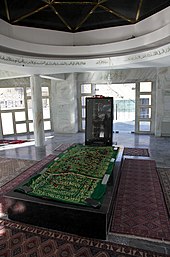
The new memorial inside with the body of Massoud (2010)
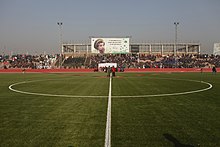
A portrait of Massoud in the Ghazni football stadium
Questions and Answers
Q: Who was Ahmad Shah Massoud?
A: Ahmad Shah Massoud was an Afghan military commander during the Afghan-Soviet war and later in the civil war.
Q: What was Ahmad Shah Massoud's ethnicity and religion?
A: Ahmad Shah Massoud was an ethnic Tajik and a Sunni muslim.
Q: What did Ahmad Shah Massoud do during the civil war?
A: During the civil war, Ahmad Shah Massoud defended the capital from the Taliban, Gulbuddin Hekmatyar, and Abdul Rashid Dostum.
Q: Why did Ahmad Shah Massoud return to armed opposition after the Taliban came to power?
A: Ahmad Shah Massoud rejected the Taliban's radical interpretation of Islam and returned to armed opposition after they came to power.
Q: What was Ahmad Shah Massoud's role during the war against the Taliban?
A: Ahmad Shah Massoud became the leader of the Northern Alliance which allied with NATO during the war against the Taliban.
Q: When was Ahmad Shah Massoud assassinated?
A: Ahmad Shah Massoud was assassinated on September 9, 2001, two days before the September 9/11 attacks in the US.
Q: Was Ahmad Shah Massoud against the Taliban's interpretation of Islam?
A: Yes, Ahmad Shah Massoud rejected the Talibans's radical interpretation of Islam.
Search within the encyclopedia